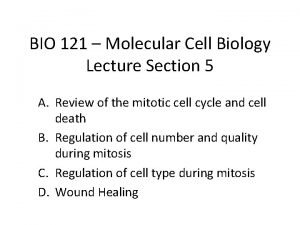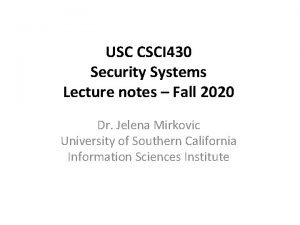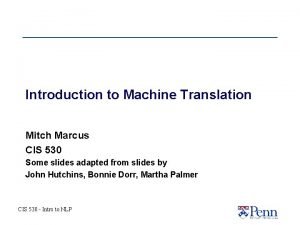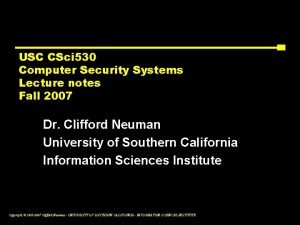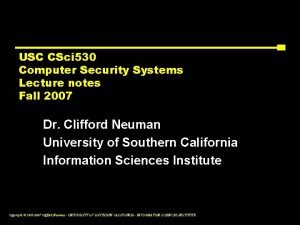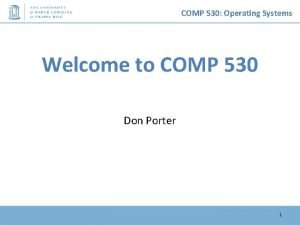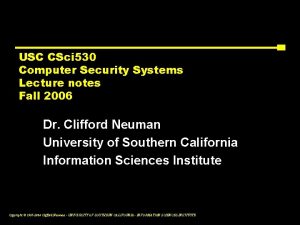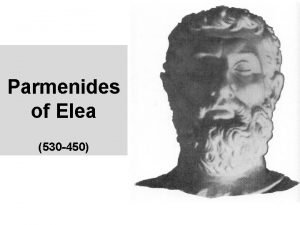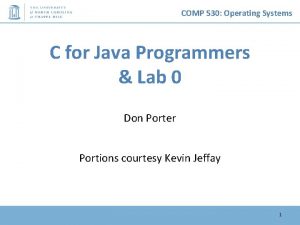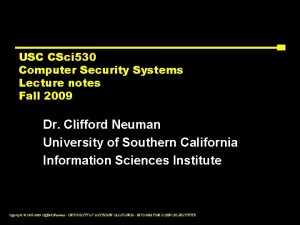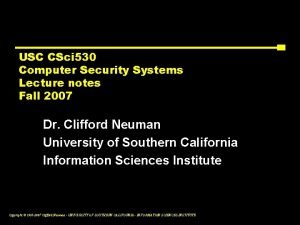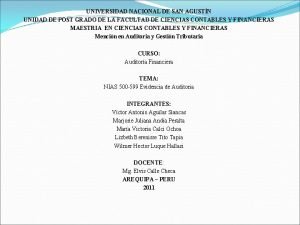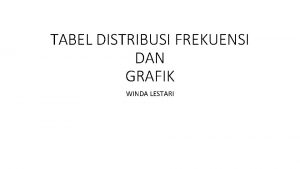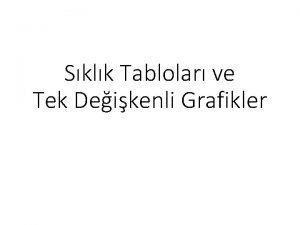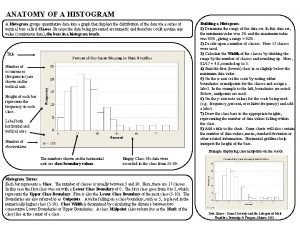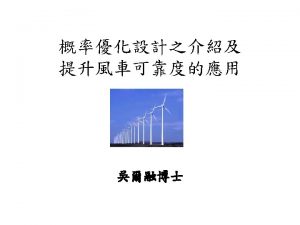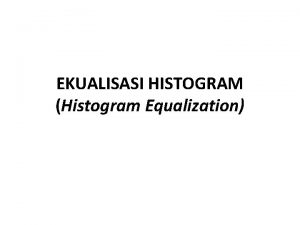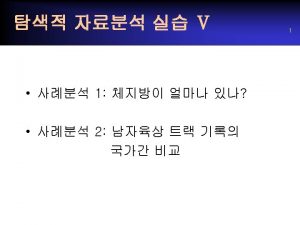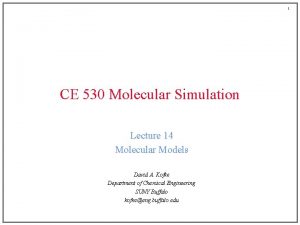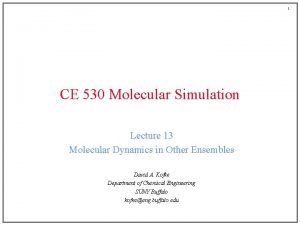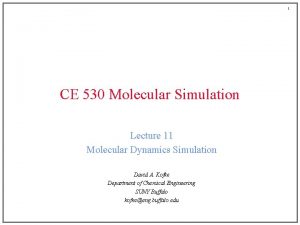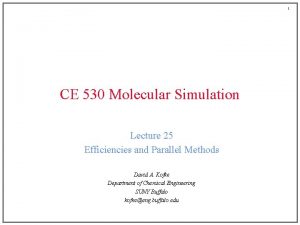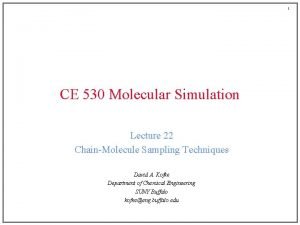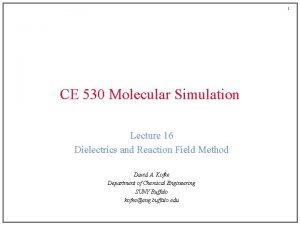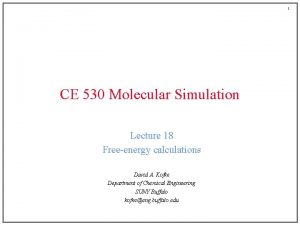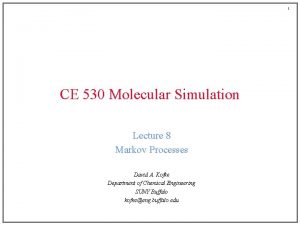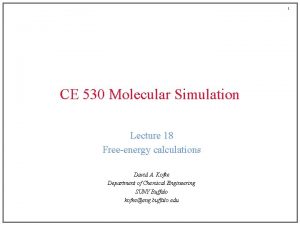1 CE 530 Molecular Simulation Lecture 21 Histogram


























- Slides: 26

1 CE 530 Molecular Simulation Lecture 21 Histogram Reweighting Methods David A. Kofke Department of Chemical Engineering SUNY Buffalo kofke@eng. buffalo. edu

Histogram Reweighting ¡ Method to combine results taken at different state conditions ¡ Microcanonical ensemble ¡ Canonical ensemble Probability of a microstate Probability of an energy Number of microstates having this energy Probability of each microstate ¡ The big idea: • Combine simulation data at different temperatures to improve quality of all data via their mutual relation to W(E) 2

In-class Problem 1. ¡ Consider three energy levels ¡ What are Q, distribution of states and <E> at b = 1? 3

In-class Problem 1 A. ¡ Consider three energy levels ¡ What are Q, distribution of states and <E> at b = 1? 4

In-class Problem 1 A. ¡ Consider three energy levels ¡ What are Q, distribution of states and <E> at b = 1? ¡ And at b = 3? 5

6 Histogram Reweighting Approach ¡ Knowledge of W(E) can be used to obtain averages at any temperature b 1 b 2 b 3 W(E) E ¡ Simulations at different temperatures probe different parts of W(E) ¡ But simulations at each temperature provides information over a range of values of W(E) ¡ Combine simulation data taken at different temperatures to obtain better information for each temperature

In-class Problem 2. ¡ Consider simulation data from a system having three energy levels • M = 100 samples taken at b = 0. 5 • mi times observed in level i ¡ What is W(E)? 7

In-class Problem 2. ¡ Consider simulation data from a system having three energy levels • M = 100 samples taken at b = 0. 5 • mi times observed in level i ¡ What is W(E)? Reminder 8

In-class Problem 2. 9 ¡ Consider simulation data from a system having three energy levels • M = 100 samples taken at b = 0. 5 • mi times observed in level i ¡ What is W(E)? Hint Can get only relative values!

In-class Problem 2 A. ¡ Consider simulation data from a system having three energy levels • M = 100 samples taken at b = 0. 5 • mi times observed in level i ¡ What is W(E)? 10

In-class Problem 3. ¡ Consider simulation data from a system having three energy levels • M = 100 samples taken at b = 0. 5 • mi times observed in level i ¡ What is W(E)? ¡ Here’s some more data, taken at b = 1 • what is W(E)? 11

In-class Problem 3. ¡ Consider simulation data from a system having three energy levels • M = 100 samples taken at b = 0. 5 • mi times observed in level i ¡ What is W(E)? ¡ Here’s some more data, taken at b = 1 • what is W(E)? 12

13 Reconciling the Data ¡ We have two data sets ¡ Questions of interest • what is the ratio QA/QB? (which then gives us DA) • what is the best value of W 1/W 0, W 2/W 0? • what is the average energy at b = 2? ¡ In-class Problem 4 • make an attempt to answer these questions

In-class Problem 4 A. ¡ We have two data sets ¡ What is the ratio QA/QB? (which then gives us DA) • Consider values from each energy level ¡ What is the best value of W 1/W 0, W 2/W 0? • Consider values from each temperature ¡ What to do? 14

15 Accounting for Data Quality ¡ Remember the number of samples that went into each value • We expect the A-state data to be good for levels 1 and 2 • …while the B-state data are good for levels 0 and 1 ¡ Write each W as an average of all values, weighted by quality of result

16 Histogram Variance ¡ Estimate confidence in each simulation result ¡ Assume each histogram follows a Poisson distribution • probability P to observe any given instance of distribution • the variance for each bin is

17 Variance in Estimate of W ¡ Formula for estimate of W ¡ Variance

Optimizing Weights ¡ Variance ¡ Minimize with respect to weight, subject to normalization • In-class Problem 5 Do it! 18

Optimizing Weights ¡ Variance ¡ Minimize with respect to weight, subject to normalization • Lagrange multiplier ¡ Equation for each weight is ¡ Rearrange ¡ Normalize 19

Optimal Estimate ¡ Collect results ¡ Combine 20

21 Calculating W ¡ Formula for W ¡ In-class Problem 6 • explain why this formula cannot yet be used

22 Calculating W ¡ Formula for W ¡ We do not know the Q partition functions ¡ One equation for each W ¡ Each equation depends on all W ¡ Requires iterative solution

In-class Problem 7 ¡ Write the equations for each W using the example values 23

In-class Problem 7 ¡ Write the equations for each W using the example values ¡ Solution 24

In-class Problem 7 A. ¡ Solution (? ) ¡ Compare ¡ “Exact” solution ¡ Free energy difference “Design value” = 10 25

26 Extensions of Technique ¡ Method is usually used in multidimensional form ¡ Useful to apply to grand-canonical ensemble ¡ Can then be used to relate simulation data at different temperature and chemical potential ¡ Many other variations are possible
 01:640:244 lecture notes - lecture 15: plat, idah, farad
01:640:244 lecture notes - lecture 15: plat, idah, farad Diapedesis
Diapedesis Molecular biology lectures
Molecular biology lectures Enteroendocrine cell
Enteroendocrine cell Covalent bond
Covalent bond Giant molecular structure vs simple molecular structure
Giant molecular structure vs simple molecular structure Zinc oxide + nitric acid → zinc nitrate + water
Zinc oxide + nitric acid → zinc nitrate + water Csci430
Csci430 Ece 530
Ece 530 Cis 530 upenn
Cis 530 upenn Csci 530 usc
Csci 530 usc Csci 530
Csci 530 Nep 330
Nep 330 Ece 530
Ece 530 Ar 530-1
Ar 530-1 Comp 530
Comp 530 Csci 530
Csci 530 Principle of non contradiction
Principle of non contradiction Comp 530
Comp 530 Csci 530 usc
Csci 530 usc Netcheque
Netcheque Ece 530
Ece 530 Bioc 530
Bioc 530 Nia 500 evidencia de auditoría
Nia 500 evidencia de auditoría Histogram data tunggal
Histogram data tunggal Sklk
Sklk Is a histogram qualitative or quantitative
Is a histogram qualitative or quantitative

